We love sweet corn in my home! I don’t have to tell my girls twice to eat their vegetables when sweet corn is being served. It’s a homegrown taste that I like to have all year long. Suprisingly, I have NEVER personally grown sweet corn in my garden. Crazy, I know! In my logic, I think it’s a waste to use up my little backyard garden plot to grow sweet corn when my dad plants acres of it. He grows the most flavorful sweet corn I have ever had the pleasure of tasting. And even better, he likes to share it with his favorite daughter.
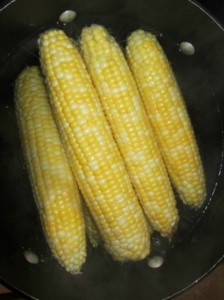 We graze on sweet corn all summer long, and thankfully, it is a summer flavor that can easily be preserved for winter. My mom taught me how to freeze corn; now I am passing on the tradition and skill to my daughters. Before I show you how easy freezing corn can be, let me define a few terms — let’s call it “Sweet Corn 101.”
We graze on sweet corn all summer long, and thankfully, it is a summer flavor that can easily be preserved for winter. My mom taught me how to freeze corn; now I am passing on the tradition and skill to my daughters. Before I show you how easy freezing corn can be, let me define a few terms — let’s call it “Sweet Corn 101.”
- Sweet corn is a type of corn that is high in sugar (that’s why it tastes so good). It is not the field corn you see when driving rural America. Field corn and sweet corn are two different varieties. Sweet corn is picked when it is immature (soft) and the corn stalk is still green. In contrast, field corn is harvested when it is mature (hard) and the corn stalk is brown and dead.
- Kernels are the little fruit on the sweet corn cob. When picked at perfect ripeness, they just pop in your mouth as you eat corn on the cob.
- An ear of corn refers to the entire ear: kernels, cob, husk, and silk.
- Husks are the leaves wrapped around the ear.
- The silk (hairs) are the female part of the plant. Each kernel has one silk, and without a silk, the kernel will not be fertilized and will not mature.
- Cob is what is left over when you have removed the husk, silk, and kernels.
- Husking or shucking is the process of removing the husk and silk.
Now that you have the right corn terminology, let’s get started.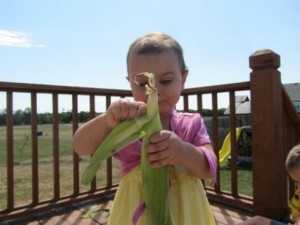
1. Obtain a large amount of sweet corn. Your source might be your own garden, the famers market, a roadside stand, or your dad. Consider how much to obtain; it all depends upon how much work you want to do and how much freezer space you have. Try to get the corn as fresh as possible. Hopefully you can freeze it the same day it was picked. If not, put the sweet corn in a refrigerator or on ice until you can get to it.
2. Shuck the corn. Removing the husk and silk from the corn is a process that can involve the entire family. Even a two-year-old can help as you can see from the picture. Removing the silk can be a tedious task; some people use a brush or a cloth to clean all the hair off of the ear. I have trained my children to accept corn hair as part of eating sweet corn.
3. Boil the sweet corn for four minutes (I actually boil my sweet corn for three minutes because that is how my mom taught me but all the research that I have done said that it should be cooked for four minutes). To prepare, I fill a large pot two-thirds full of water and bring to a rolling boil. Once you add corn to the water, the water should quickly return (within a minute) to a boil. If not you have too much corn in the pot. This process is called blanching, it stops the enzymes that breakdown the flavor, color, and texture of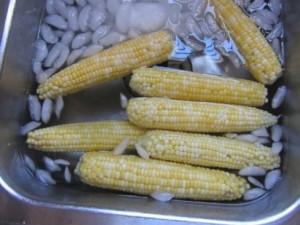 the corn during storage.
the corn during storage.
4. Cool the corn. To stop the cooking process, take the corn from the boiling water into an ice bath. You can use a large pot or your kitchen sink to hold the ice.
5. Cut the kernels from the cob. You don’t need a special tool, (although there are some out there you can buy) just a sharp knife. I cut at about a two-thirds depth, this way I am not getting any of the cob, just the sweet tasting kernel. In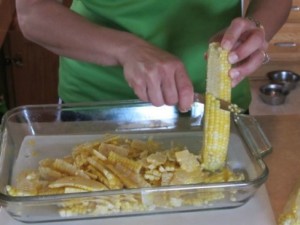 the past, I have used the hole in an angel food cake pan to hold the ear in place. When you cut, the kernels fall right into the pan.
the past, I have used the hole in an angel food cake pan to hold the ear in place. When you cut, the kernels fall right into the pan.
6. Scoop the corn into a labeled freezer bag. I don’t fill each bag full; I add just what my family will eat at one serving, about two and a half cups. It’s important to remove as much air from the bag as possible to prevent drying and freezer burn.
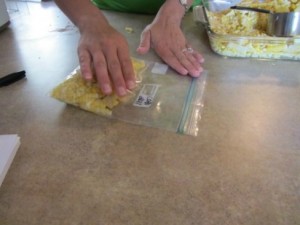 7. Immediately put the corn in the freezer. When you are ready to feed your family some summer goodness, just heat and serve.
7. Immediately put the corn in the freezer. When you are ready to feed your family some summer goodness, just heat and serve.
I hope you see how easy the process of freezing sweet corn can be. My girls refuse to eat any canned corn I buy at the grocery store. They have been spoiled with a fresh homegrown taste! As a mom, I’m grateful for the fertile soil and little corn seeds that produced a winter full of sweet corn for my family.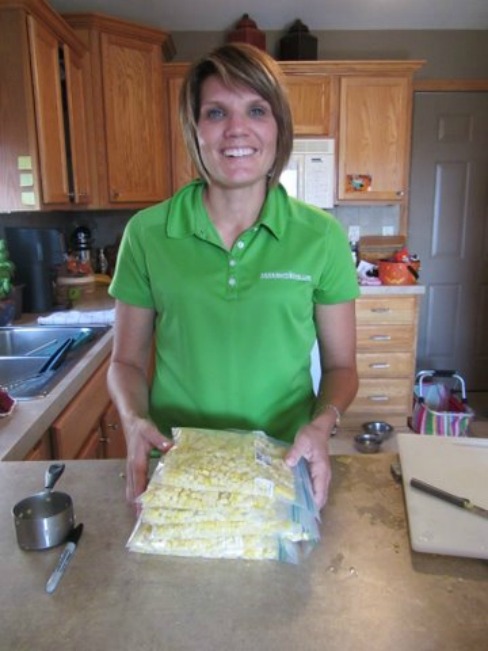






I enjoyed reading your comments about freezing corn. We have frozen corn fresh from our garden for several years, but you gave us some new ideas. Next time we freeze corn we will try those NEW ideas.
Do you add any salt, sugar or anything else to the bag before you freeze your corn. thanks
Larry, I do not add anything else to the corn. Our corn is very sweet and I don’t feel it needs extra sugar to enhance the flavor. I add salt when I am preparing a meal, not at freezing time. This is my preference. Thanks for your question. Dee McKenna